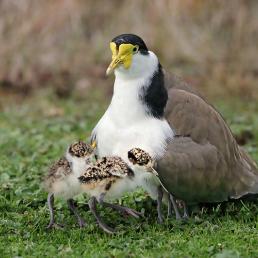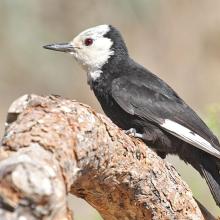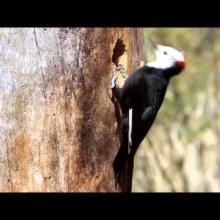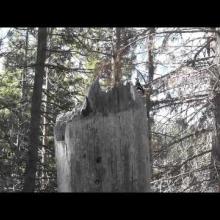

Join BirdNote tomorrow, November 30th!
Illustrator David Sibley and actor H. Jon Benjamin will face off in the bird illustration battle of the century during BirdNote's Year-end Celebration and Auction!
The White-headed Woodpecker is widely scattered and nowhere common in the Pacific Northwest. Like other woodpeckers, the White-headed Woodpecker digs out juicy insect larvae from the trees by pounding with its sharp bill. But by holding its bill at an angle, the White-headed Woodpecker also flakes off big pieces of bark. In fact, one way to find these woodpeckers is by looking for lighter areas on pine trunks where they have pried free the bark.
Support for BirdNote comes from the Cornell Lab of Ornithology, presenting its new “Bird Photography” online course, featuring Melissa Groo. Learn more at academy.allaboutbirds.org.
This page is sponsored by Mark DeWeirdt and Dorothy Ling in honor of
Tom and Annalee Luhman and in celebration of their 50th Wedding Anniversary. Thanks for supporting the new BirdNote.org, coming in 2020!
BirdNote®
White-headed Woodpecker - The Quiet Woodpecker
Written by Dennis Paulson
This is BirdNote!
[Woodpecker drumming]
Walk through a grove of Ponderosa pines in the Cascade Mountains, and you’ll often encounter woodpeckers. [White-headed Woodpecker call]
This one is a White-headed Woodpecker, “...the only North American bird with [a] black body and white head.” (1) A patch of bright red on the back of the male’s head catches your eye. [White-headed Woodpecker drumming] The species is widely scattered, though nowhere common, in mountain regions from southern British Columbia to southern California. It also has some peculiar habits.
Like other woodpeckers, the White-headed digs out juicy insect larvae from the trees by pounding with its sharp bill. [Foraging sounds of White-headed Woodpecker] But by holding its bill at an angle, it also flakes off big pieces of bark. In fact, one way to find these woodpeckers is by looking for lighter areas on pine trunks where they’ve pried free the bark. They're quiet birds, not always obvious, but listen for their double call. [White-headed Woodpecker call]
As White-headed Woodpeckers eat the big seeds hidden in Ponderosa pine cones, they hang below the cone so their feathers don’t get sticky from resin. They may take a seed to a nearby trunk, wedge it in a crack in the bark, and peck it apart to swallow the pieces.
Hey! There’s one now! [White-headed Woodpecker call]
The bird sounds we feature on BirdNote come from The Macaulay Library at the Cornell Lab of Ornithology. I’m Mary McCann. [White-headed Woodpecker drumming]
Support for BirdNote comes from the Cornell Lab of Ornithology, presenting its new “Bird Photography” online course, featuring Melissa Groo. Learn more at academy.allaboutbirds.org.
###
Bird sounds provided by The Macaulay Library of Natural Sounds at the Cornell Lab of Ornithology, Ithaca, New York. Call of the White-headed Woodpecker [73856] recorded by W.L. Hershberger; drumming [107612] by D.S. Herr, foraging sounds [148084] recorded by N. Young.
BirdNote’s theme music was composed and played by Nancy Rumbel and John Kessler.
Producer: John Kessler
Executive Producer: Chris Peterson
© 2014 Tune In to Nature.org June 2017/2020 Narrator: Mary McCann
ID# 062007WHWOKPLUWHWO-01-2009-06-28 WHWO-01b
1 - The Sibley Guide to Birds, written and illustrated by David Sibley, publisher Alfred A. Knopf, Inc., 2000.






